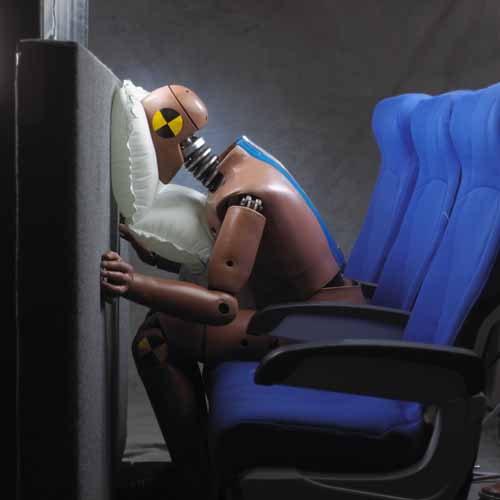
Buckle up, you dummy!
Airbags on airplanes have arrived and they’re not just a special perk for first-class passengers.
In fact, if you’ve been seated in a bulkhead row, near an exit-row door or in business- or first-class seats on newer planes, you may have already strapped on an airbag and not even noticed.
Unlike automobiles, airplane airbags aren’t built into the vehicle but added onto seatbelts in what looks like just some extra padding.
“Sometimes when I’m boarding a plane and see people looking around wondering why their seatbelt looks different, I stop and explain,” said Chris Muklevicz, vice president of sales and marketing for aviation restraints at AmSafe, the company that makes the only airbags certified for commercial aircraft. “But then passengers around them start asking why then don’t have them, too.”
In an interview earlier this week at the 2011 Aircraft Interiors Expo in Seattle, Muklevicz explained that seatbelts with airbags were developed as a cost-effective way for airlines to meet the Federal Aviation Administration’s (FAA) requirement that, as of October 2009, all seats on new airplanes must be “16g” seats — able to withstand stresses and impacts of up to 16 times the force of gravity. The previous requirement was 9gs.
Most seats on new airplanes do meet the guidelines in part because they have seats in front of them that can add some cushioning in an accident. Bulkhead and front-row seats and those swanky pod-like units in some first- and business-class sections often don’t. The added protection offered by a $2,000 seatbelt airbag (versus the $50 traditional seatbelt) helps bring those seats up to code.
“Airlines could remove seats from those positions, but they don’t want to lose that potential revenue,” Muklevicz said.
The new seat code was put in place because tests and real-life incidents show passengers have a good chance of surviving an accident if seats aren’t first torn from the floor during a crash. According to the National Transportation Safety Board, more than 80 percent of commercial airline accidents are survivable because they occur on the ground or during take-off or landing when the aircraft is close to the ground and flying at relatively low speeds.
Muklevicz said the seatbelt airbags are designed to keep a passenger conscious after an impact. “If the passenger is conscious and it’s possible to get out of the plane, this can make a big difference in survival if there’s smoke and fire,” he said.
Right now, there are more than 70,000 airbag-equipped seatbelts in service. Half of those are on commercial airplanes and half are on general aviation aircraft. “Luckily, it hasn’t yet been tested in a real commercial aircraft crash,” Muklevicz told me, “but there are have plenty of reports of it saving lives on private aircraft.”

AmSafe's Chris Muklevicz with seatbelt airbag
(A slightly different version of this story first appeared on msnbc.com’s Overhead Bin.)